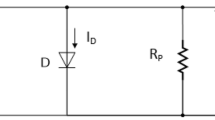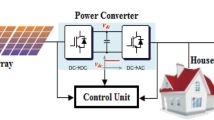Abstract
Nowadays, photovoltaic (PV) generation is growing fast as a renewable energy source. Nevertheless, the drawback of PV system is intermittent for depending on weather conditions. In this paper, a novel topology of intelligent PV system is presented. In order to capture the maximum power, hybrid fuzzy-neural maximum power point tracking method is applied in PV system. As a result, the effectiveness of the proposed method is represented and average tracking efficiency of the hybrid fuzzy-neural is incremented by approximately two percentage points in comparison with the conventional methods. It has the advantages of robustness, fast response and good performance. Detailed mathematical model and a control approach of a three-phase grid-connected intelligent hybrid system have proposed using MATLAB/Simulink.























Similar content being viewed by others
References
Rezvani A, Gandomkar M, Izadbakhsh M, Ahmadi A (2015) Environmental/economic scheduling of a micro-grid with renewable energy resources. J Clean Prod 87:216–226
Izadbakhsh M, Gandomkar M, Rezvani A, Ahmadi A (2015) Short-term resource scheduling of a renewable energy based micro grid. Renew Energy 75:598–606
Rezvani A, Izadbakhsh M, Gandomkar M (2015) Microgrid dynamic responses enhancement using artificial neural network-genetic algorithm for photovoltaic system and fuzzy controller for high wind speeds. Int J Numer Model Electron Netw Devices Fields. doi:10.1002/jnm.2078
Rezvani A, Izadbakhsh M, Gandomkar M (2015) Enhancement of microgrid dynamic responses under fault conditions using artificial neural network for fast changes of photovoltaic radiation and FLC for wind turbine. Energy Syst 6(4):551–584
Vafaei S, Gandomkar M, Rezvani A, Izadbakhsh M (2015) Enhancement of grid-connected photovoltaic system using ANFIS-GA under different circumstances. Front Energy 9(3):322–334
Liu L, Liu C, Wang J, Kong Y (2015) Simulation and hardware implementation of a hill-climbing modified fuzzy-logic for maximum power point tracking with direct control method using boost converter. J Vib Control 21(2):335–342
Oshaba AS, Ali ES, Abd Elazim SM (2015) PI controller design using ABC algorithm for MPPT of PV system supplying DC motor pump load. Neural Comput Appl. doi:10.1007/s00521-015-2067-9
De Leone R, Pietrini M, Giovannelli A (2015) Photovoltaic energy production forecast using support vector regression. Neural Comput Appl 26(8):1955–1962
Liu C, Wu B, Cheung R (2004) Advanced algorithm for mppt control of photovoltaic systems. In: Proceeding of the Canadian solar buildings conference, Montreal
Rai AK, Kaushika ND, Singh B, Agarwal N (2011) Simulation model of ANN based maximum power point tracking controller for solar PV system. Sol Energy Mater Sol Cells 95(2):773–778
Chaouachi A, Kamel RM, Nagasaka K (2010) A novel multi-model neuro-fuzzy-based MPPT for three-phase grid-connected photovoltaic system. Sol Energy 84:2219–2229
Kharb RK, Shimi SL, Chatterji S, Ansari MF (2014) Modeling of solar PV module and maximum power point using ANFIS. Renew Sustain Energy 33:602–612
Afsin A, Kulaksiz A (2012) Training data optimization for ANNs using genetic algorithms to enhance MPPT efficiency of a stand-alone PV system. Turk J Electr Eng Comput Sci 20(2):241–254
Salah CB, Mohamed MQ (2011) Comparison of fuzzy logic and neural network in maximum power point tracker for PV systems. Electr Power Syst Res 81:43–50
Rezvani A, Izadbakhsh M, Gandomkar M (2015) Enhancement of hybrid dynamic performance using ANFIS for fast varying solar radiation and fuzzy logic controller in high speeds wind. J Electr Syst 11(1):11–26
Vincheh RM, Kargar A, Markadeh GA (2014) A hybrid control method for maximum power point tracking (MPPT) in photovoltaic systems. Arab J Sci Eng 39(6):4715–4725
Izadbakhsh M, Rezvani A, Gandomkar M (2014) Improvement of microgrid dynamic performance under fault circumstances using ANFIS for fast varying solar radiation and fuzzy logic controller for wind system. Arch Electr Eng 63(4):551–578
Hadji S, Krim F, Gaubert JP (2011) Development of an algorithm of maximum power point tracking for photovoltaic systems using genetic algorithms. In: 7th International Workshop on systems, signal processing and their applications (WOSSPA), pp 43–46
Long J, Chen Z (2011) Research on the MPPT algorithms of photovoltaic system based on PV neural network. In: Control and decision conference (CCDC), pp 1851–1854
Csuo C, Zhang W, Wu G, Gui J, Zhao L, Ma C (2015) Modelling and simulation of MPPT algorithm for pv grid-connected system. Integr Ferroelectr Int J 162:18–23
Rajani SV, Pandya VP (2015) Simulation and comparison of perturb and observe and incremental conductance MPPT algorithms for solar energy system connected to grid. Sadhan 40:139–153
Mohanty P, Bhuvaneswari G, Balasubramanian R, Dhaliwal NK (2014) MATLAB based modeling to study the performance of different MPPT techniques used for solar PV system under various operating conditions. Renew Sustain Energy Rev 40: 139–153, 38: 581–593
Ahmed J, Salam Z (2015) An improved perturb and observe (P&O) maximum power point tracking (MPPT) algorithm for higher efficiency. Appl Energy 150:97–108
Fathabadi H (2015) Fuel cell/back-up battery hybrid energy conversion systems: dynamic modeling and harmonic considerations. Energy Convers Manag 103:573–584
Blaabjerg F, Teodorescu R, Liserre M (2006) Overview of control and grid synchronization for distributed power generation systems. IEEE Trans Ind Electron 53(5):1398–1409
Author information
Authors and Affiliations
Corresponding author
Appendix: Description of the detailed model
Appendix: Description of the detailed model
PV parameters Output power = 4.4 kW, carrier frequency in V MPPT PWM generator = 4.3 kHz and in grid-side controller = 5 kHz, boost converter parameters: L = 3.5 mH, C = 630 µF, PI coefficients in grid-side controller: K pVdc = 3.5, K iVdc = 7.3, K pId = 8.4, K iId = 343, K pIq = 8.4, K iIq = 343.
Rights and permissions
About this article
Cite this article
Rezvani, A., Gandomkar, M. Simulation and control of intelligent photovoltaic system using new hybrid fuzzy-neural method. Neural Comput & Applic 28, 2501–2518 (2017). https://doi.org/10.1007/s00521-016-2210-2
Received:
Accepted:
Published:
Issue Date:
DOI: https://doi.org/10.1007/s00521-016-2210-2




